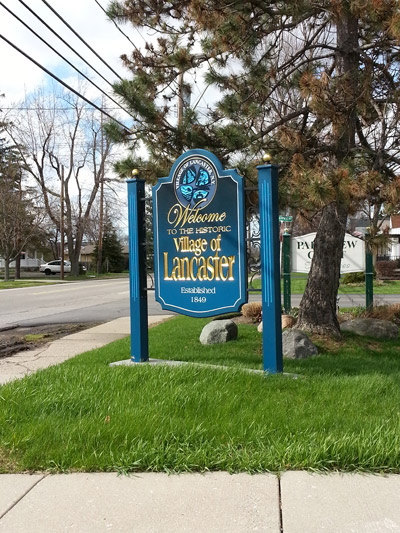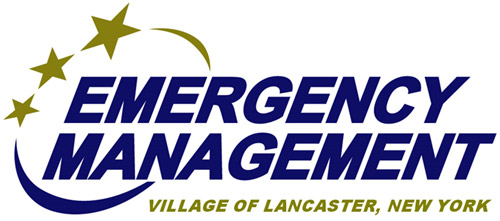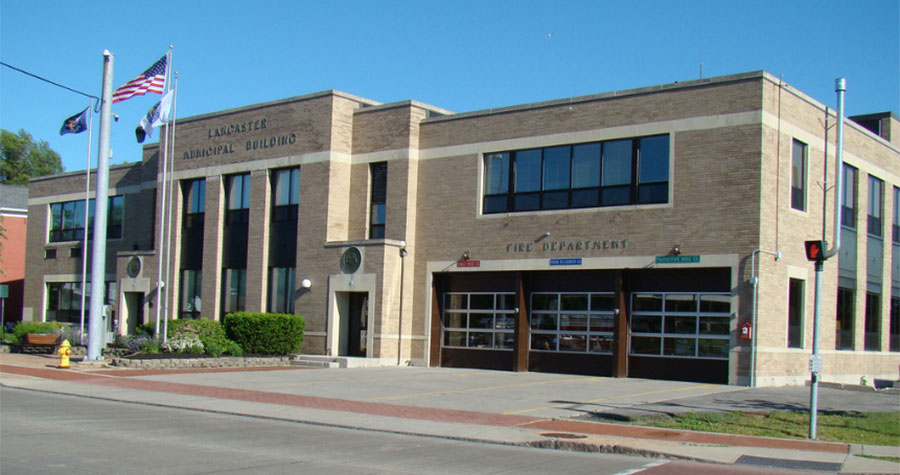
The Village of Lancaster Office of Emergency Management is actively involved in preparedness activities such as community hazard assessments, multi-jurisdictional hazard mitigation planning, maintaining National Incident Management System NIMS training compliance, maintenance of a special needs registry, drills/exercises, public/private outreach, and emergency planning for events in the Village of Lancaster Special Events Series.
The Village of Lancaster OEM operates out of the Lancaster Municipal Building located at 5423 Broadway in Lancaster. This building also serves as the Emergency Operations Center (EOC) for use during emergencies. The OEM office is equipped with backup generator power and essential equipment and resources necessary for operations.
The Village of Lancaster OEM automatically responds to major incidents and alarms involving at-risk facilities and is capable of deploying mobile resources to assist with emergency operations. Emergencies requiring assets beyond the scope of our agency are supplemented through mutual aid agreement, including neighboring towns and villages, Erie County Emergency Services, and public/private partnership.
Community Demographics
- A Buffalo Niagara International Airport (BNIA) flight path crosses the Village of Lancaster, two miles from Runway 32
- Village of Lancaster Population: Approximately 11,000 residents
- An active and growing industrial park
- The Village is comprised of residential, commercial, and industrial properties.
- Four active rail lines dissect the Village, along with two major state truck routes (Walden Avenue and Broadway).
- Five elementary schools, one middle school, one high school, nine churches, Como Lake Park, and the Lancaster Opera House call the Village of Lancaster home.
Quick Links

Emergency Management Pursuit
Definition
Emergency management is the managerial function charged with creating the framework within which communities reduce vulnerability to hazards and cope with disasters.
Vision
Emergency management seeks to promote safer, less vulnerable communities with the capacity to cope with hazards and disasters.
Mission
Emergency management protects communities by coordinating and integrating all activities necessary to build, sustain, and improve the capability to mitigate against, prepare for, respond to, and recover from threatened or actual natural disasters, acts of terrorism, or other man-made disasters.
Principles
Emergency management must be:
- Comprehensive – emergency managers consider and take into account all hazards, all phases, all stakeholders and all impacts relevant to disasters.
- Progressive – emergency managers anticipate future disasters and take preventive and preparatory measures to build disaster-resistant and disaster-resilient communities.
- Risk-driven – emergency managers use sound risk management principles (hazard identification, risk analysis, and impact analysis) in assigning priorities and resources.
- Integrated – emergency managers ensure unity of effort among all levels of government and all elements of a community.
- Collaborative – emergency managers create and sustain broad and sincere relationships among individuals and organizations to encourage trust, advocate a team atmosphere, build consensus, and facilitate communication.
- Coordinated – emergency managers synchronize the activities of all relevant stakeholders to achieve a common purpose.
- Flexible – emergency managers use creative and innovative approaches in solving disaster challenges.
- Professional – emergency managers value a science and knowledge-based approach based on education, training, experience, ethical practice, public stewardship and continuous improvement.
Lancaster OEM History
The Director of Emergency Management (CD-136) reports to the Mayor of the Village of Lancaster. The Director of Emergency Management is responsible for emergency preparedness, response and recovery for the Village pursuant to NYS Executive Law Article 2-B. The Director of Emergency Management has the authority to request and accept assistance and deploy the local resources of the Village of Lancaster under the intra-state mutual aid program. Local governments assisting the Village of Lancaster are under the direction and control of Director of Emergency Management.
In the event of a disaster, rioting, catastrophe, or similar public emergency within the territorial limits of the Village of Lancaster, or in the event of reasonable apprehension of immediate danger thereof, the Mayor may proclaim a local state of emergency within any part or all of the territorial limits of the Village. The Mayor may promulgate local emergency orders to protect life and property or to bring the emergency situation under control. Such orders may include:
- the establishment of a curfew and the prohibition and control of pedestrian and vehicular traffic, except essential emergency vehicles and personnel;
- the designation of specific zones within which the occupancy and use of buildings and the ingress and egress of vehicles and persons may be prohibited or regulated;
- the regulation and closing of places of amusement and assembly;
- the suspension or limitation of the sale, dispensing, use or transportation of alcoholic beverages, firearms, explosives, and flammable materials and liquids;
- the prohibition and control of the presence of persons on public streets and places;
- the establishment or designation of emergency shelters, emergency medical shelters, and in consultation with the state commissioner of health, community based care centers;
- the suspension within any part or all of its territorial limits of any of its local laws, ordinances or regulations, or parts thereof subject to federal and state constitutional, statutory and regulatory limitations, which may prevent, hinder, or delay necessary action in coping with a disaster or recovery therefrom.
Over the years the Village of Lancaster Office of Emergency Management has been involved in a number of local incidents involving fires, flooding, hazardous materials, and severe weather events and large-scale incidents, including Y2K preparations, October Storm 2006, Northeast blackout, and September 11 terrorist attacks.
Meet The Director

The Village of Lancaster Office of Emergency Management is led by OEM Director Scott M. Kuhlmey (seen to the right). He holds a degree concentrating in Disaster & Emergency Management from the Rochester Institute of Technology (R.I.T.), as well as a degree in Fire Protection Technology from SUNY Erie. He is a former adjunct instructor for the Rochester Institute of Technology (R.I.T.), leading the Fire Protection curriculum.
Kuhlmey successfully completed the Disaster & Emergency Management Certificate Program at the Rochester Institute of Technology, the Safety & Health Specialist Certificate Program at the Niagara County Community College, and the FEMA Professional Development Series in Emergency Management. Additionally, he is a member of the Erie County Sheriff’s Office Type 4 All-Hazard Incident Management Team responsible for managing and/or assisting other agencies in managing major and/or complex incidents. Kuhlmey is the recipient of awards, including:
- Lancaster Fire Department, Erie County Fire Chiefs Mutual Aid Organization, Erie County Volunteer Firemen's Association, and Lions Club of Lancaster Firefighter of the Year
- Bravest of Western New York by WIVB Channel 4 / WNLO Channel 23 for his rescue of a victim from a house fire in December 2006
- New York State Senate Liberty Award and Medal, the highest honor that the State Senate bestows upon a civilian for heroic action, exceptional achievement, and dedication
- Firemen\'s Association of the State of New York (FASNY) Meritorious commendation
- Lions Club District 20-N Courageous Hero Award
- ECSO William G. Payne Patrol Services Award for his commitment to excellence and his sense of duty as a fire and crime scene investigator
Kuhlmey is a member of the Erie County Emergency Manager Association, Erie County Local Emergency Planning Committee LEPC, and Emergency Managers’ Association of Western New York amongst others. He holds a number of professional certifications, including, NYS Fire Inspector, NYS Fire Instructor, NYS Fire Officer II, NYS Hazardous Materials Technician, NYS National Incident Management System (NIMS) Instructor, NYS Code Enforcement Official, NYS & ProBoard Fire Investigator, and ProBoard Certified Firefighter II.
Kuhlmey is a former member of the Lancaster Volunteer Ambulance Corps and Erie County Hazardous Materials Organization, in addition to 15 years as an experienced professional in safety management and emergency planning/response in industrial and educational sectors. He is a Detective with the Erie County Sheriff's Office, with responsibilities as Fire Investigator, ATF Accelerant Detection Canine Handler, Crime Scene Investigator, Crisis Negotiator, Field Training Officer and general topics instructor. He is the Fire Inspector for the Village of Lancaster, as well as 31-year member and former Fire Chief of the Lancaster Fire Department.
Four Phases Of Emergency Management
Mitigation
Preventing future emergencies or minimizing their effects
- Includes any activities that prevent an emergency, reduce the chance of an emergency happening, or reduce the damaging effects of unavoidable emergencies.
- Buying flood and fire insurance for your home is a mitigation activity.
- Mitigation activities take place before and after emergencies.
Preparedness
Preparing to handle an emergency
- Includes plans or preparations made to save lives and to help response and rescue operations.
- Evacuation plans and stocking food and water are both examples of preparedness.
- Preparedness activities take place before an emergency occurs.
Response
Responding safely to an emergency
- Includes actions taken to save lives and prevent further property damage in an emergency situation. Response is putting your preparedness plans into action.
- Seeking shelter from a tornado or turning off gas valves in an earthquake are both response activities.
- Response activities take place during an emergency.
Recovery
Recovering from an emergency
- Includes actions taken to return to a normal or an even safer situation following an emergency.
- Recovery includes getting financial assistance to help pay for the repairs.
- Recovery activities take place after an emergency.


